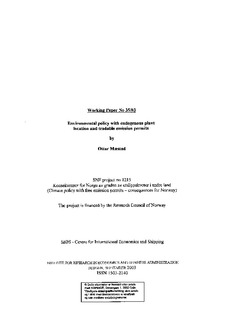| dc.description.abstract | A game between governments that solve environmental problems through tradable emission permits is analysed. We find that emission levels are chosen according to Pigouvian rule, while internationally mobile firms may receive free emission permits as a location incentive. The equilibrium number of free emission permits is shown to depend on the type of environmental problem (local vs. global), the effect of firm entry on abatement costs in the rest of the economy, whether emission permits are internationally tradable or not, and the existing level of profit taxes. The introduction of tradable emissions permits fundamentally changes previous results in the literature on endogenous plant location. For instance, the NIMBY (Not In My Back Yard) type of environmental policy will no longer be implemented. | en |
